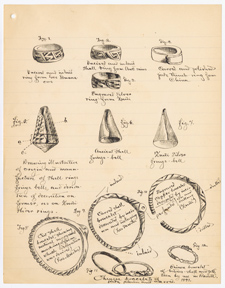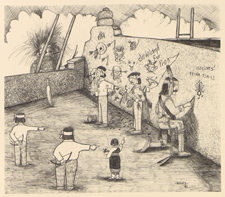
Vanished Worlds, Enduring People
Anthropologists & Native Americans
F. H. Cushing. Daily Report of Hemenway Southwestern Archaeological Expedition. March 4, 1888. [view] | [download a PDF of the entire report (18mb)]
The Hemenway Expedition, named for its patron, Mary Hemenway, was the first major scientific archaeological investigation in the Southwest. Its controversial director, Frank Hamilton Cushing (1857-1900), was already known to the world as the man who had lived with the Zuni Indians. The expedition (1886-1894) was plagued with problems, including the health and erratic behavior of its director. Today, scholars are reevaluating the significance of Cushing’s ethnographic work and the role of the Hemenway Expedition in the history of American anthropology.
Camp Hemenway, the site of this “Daily Report,” was located nine miles southeast of Tempe in Arizona Territory. In its accompanying sketches, Cushing compares objects from the nearby Los Muertos and Los Guanacos archaeological sites, with contemporary work from Zuni Pueblo and objects from China.
Phil Hughte. A Zuni Artist Looks at Frank Hamilton Cushing. Zuni, NM: Pueblo of Zuni Arts & Crafts, A:Shiwi A:wan Museum and Heritage Center, 1994. [view]
The author reverses standard anthropologist-Indian roles in this book of tongue-in-cheek cartoons that gently mock Cushing’s life, both at Zuni (1879-1884) and afterwards. Here, he refers to Cushing’s elevation to Bow Priest of the Warrior Society, a position of leadership in Zuni society.
